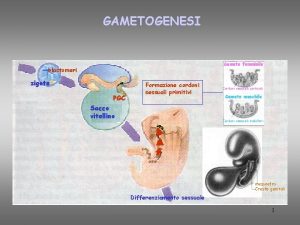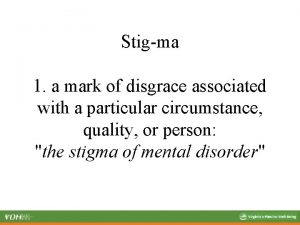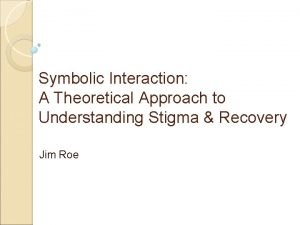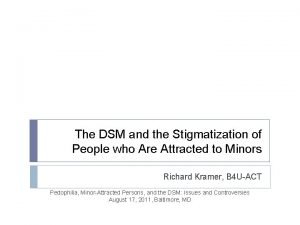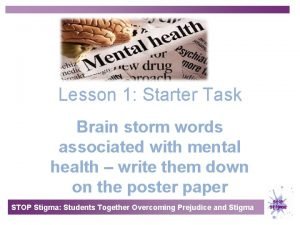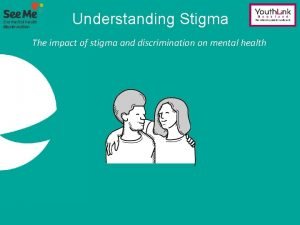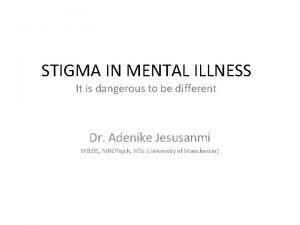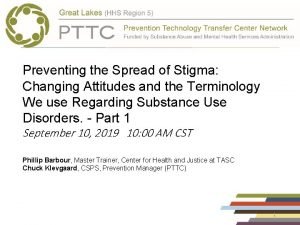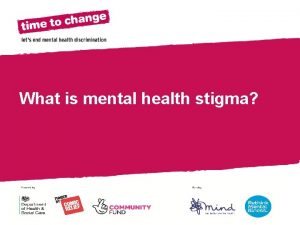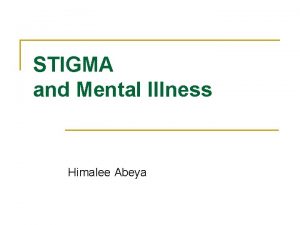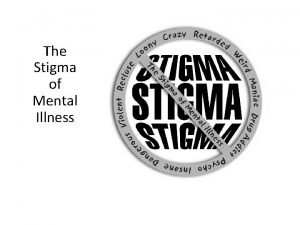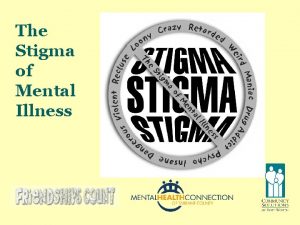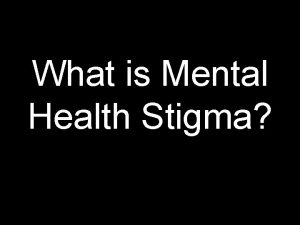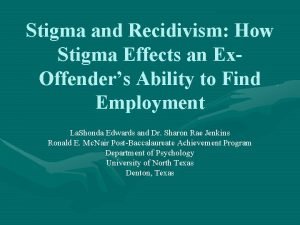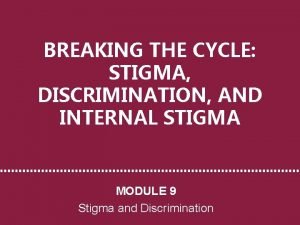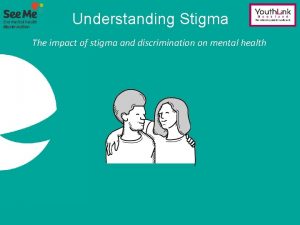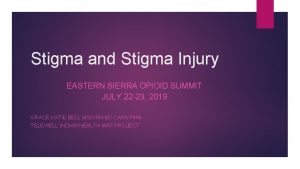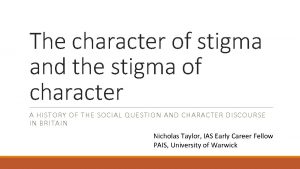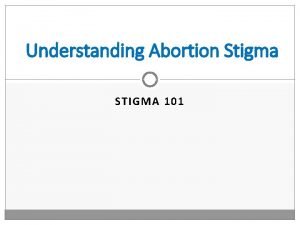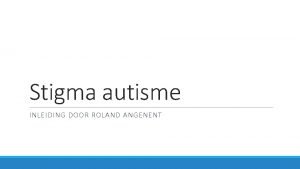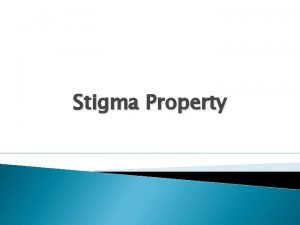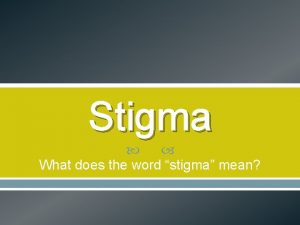Stigma and Mental Health Youth with Mental and





















- Slides: 21

Stigma and Mental Health: Youth with Mental and Neurodevelopmental Disorders… and What Does It Mean in the Era of COVID-19? Stephen P. Hinshaw University of California, Berkeley University of California, San Francisco 4/14/20

SCCAP Webinar Stigma and Mental Health: Youth with Mental and Neurodevelopmental Disorders… and What Does It Mean in the Era of COVID-19? Presenter: Stephen Hinshaw Professor, UC Berkeley and UC San Francisco Moderator: Omar Gudino Associate Professor, University of Kansas

Audience Questions and Answers Submit a question during the webinar: • Post your questions for the Q&A segment! On right side of screen, click on the Questions tab on the Go-To-Webinar control panel, and submit your questions Upcoming webinars: Submit your ideas for our 2020 Webinar Series: sccapdiv 53@gmail. com Previous webinar recordings are available on https: //sccap 53. org/resources/education-resources/webinars/ 2020: May 12 Noon ET Addressing Intersectionality When Working with Children and Families: Applying the Multicultural Guidelines - Alfonso Mercado Ph. D, & Earl Turner Ph. D June TBA Working in Integrated Pediatric Primary Care Settings - Meghan Lines and Cheyenne Hughes-Reid July TBA Preparing for Internships Panel Discussion Sept. 11 Noon ET Children and Technology Use - Justin Parent, Ph. D Sept. 29 Noon ET Cannabis Use in Adolescents - Mary Fristad, Ph. D Fall 2020 R. Bob Smith Excellence in Assessment Webinar, Free Member CE – Catherine Lord, Ph. D

Objectives • Understand the concept of stigma • Many new attendees today, since February webinar, so a bit of ‘basics’ • What about stigma related to youth mental and neurodevelopmental disorders? • What can be done to overcome stigma? • What about stigma—and the need for ‘social distancing’—in the era of COVID-19?

Stigma Hinshaw (2007), The Mark of Shame (Oxford U. Press) • Ancient Greece: Literal ‘mark of shame’ • Brands placed on slaves or traitors • Today, usually psychological /social “branding” • Which groups are stigmatized? • Racial minorities, sexual minorities, women, left-handers, physical disabilities, adoptees, obese, delinquent youth, mental illness, developmental disorders… • Can things change? See attitudes re: gay marriage • Thus, hope for optimism—malleability of social/cultural views • Most stigmatized today: • People with mental illness, homelessness, substance abuse


Major Change in Perspective • Conceptions of stigma today: • Stigmatizing processes part of ‘normative’ social cognition • Important distinction between explicit and implicit bias/stigma • Thus, distinguish… • Stereotypes (cognitive) • Prejudice (affective) • Discrimination (behavioral) • Stigma • All this plus…global nature of castigation/self-fulfilling prophecies • Important: • Although public knowledge is up, public attitudes have not changed in 60 years (and actually far worse in terms of perceptions of violence)

Evidence for MI Stigma and Discrimination • Studies of overt attitudes • S. Fiske: “lowest of the low” • Perceived as lacking in both warmth and competence • Insula--‘lights up’ with relevant images (disgust) • B. Pescosolido: National survey of adults • Re: children with depression or ADHD--stigma prevalent • Covert/implicit attitudes • Rejection occurs at unconscious level • Examination of laws and everyday practices • In many states, no vote/jury/driving/run for office/child custody • Media portrayals (still dominated by school shootings) • Until relatively recently, Massachusetts ‘stubborn child law’

Why Such Stigma? We need only a year’s seminar to discuss… • Threat theory: • Threatens perceiver’s sense of stability, may ‘prime’ sickness/death fears • Control: • Attribution theory: Negative attributes believed to be controllable are more stigmatized (thus, medical model should help) • Structural Reasons: • System justification, in hierarchical societies (all!): If those lower in the hierarchy are to blame for their own ills, we sleep more soundly at night

Reasons #2 • Conditioning: • Pervasive media images of violence, incompetence • Evolutionary : • Natural Selection for bonds AND for lack of disease/exploitation • Kurzban & Leary (2001), Psychological Bulletin: ‘modules’ linked to infestation, low social capital, and ‘difference’ • Dehumanization: • Perception that person with mental illness or NDD isn’t fully human • Martinez et al. (2011): single word changes perceptions • Magnified for children • Most didn’t survive infancy until recent era in human history • Property, valued for ability to work and/or learn • Doubly magnified for children with disabilities (see below)

Self-stigma (internalized stigma) • Nearly all members of stigmatized groups are aware of the culture’s stereotypes/beliefs/practices • Thus, likelihood (though not certainty) that such individuals will internalize these beliefs • Even adjusting for initial levels of symptoms, self-stigma predicts (a) lack of treatment seeking and (b) early termination from treatment • Antidotes: advocacy, self-help, social power • Importance for parents of youth with ‘differences’

Courtesy Stigma—and Families • Goffman (1963): • If society has stigmatized a given class of people, it’s common courtesy to stigmatize those associated with such individuals, particularly family members • Parents of youth with mental disorders: Directly blamed for offspring’s problems for decades • Even genetic transmission places blame on parents • Objective burden and subjective burden • Subjective burden usually experienced as worse • Mental health professionals/scientists ‘in the shadow’

Child Mental Disorders, NDD’s, ASD • Stigma remains high overall • Not just for most severe forms of MD or NDD • High-functioning vs. more severe ASD • Stigma perceived as HIGHER by parents former • ADHD: why would it be stigmatized? • Its very inconsistency is crucial for attributions of control • LD: Youth seems ‘smart’—must be lack of effort

And…. • Trauma • Effects must be considered (e. g. , ACEs research) • But beware of attributions of permanence • E. g. , for traumatized youth, or those detained/warehoused at border • I worry about news emphasizing the permanent scars • Indeed, perhaps the largest antidote to stigma is (a) evidencebased treatment and (b) potential for resilience

Multi-level Problem/Multi-level Solutions • Systems: Non-discrimination, parity, insurance, training of relevant professionals in evidence-based care • Media: Reduce the prevalence of images of incompetence and/or violence • Individual/Social: Humanization, contact, acceptance • With the added benefit of reducing self-stigma • Pure “education” (i. e. , teaching of facts) may in fact reinforce stereotypes and increase stigma • All of the above and more are required!

Even More…. • Is ASD a ‘difference’ (e. g. , neurodiversity) vs. a disorder (i. e. , a disorder in need of treatment)? • Should society ‘accept’ and/or should individual receive intervention? OR BOTH?


Social Distancing • Clearly, this is essential RIGHT NOW, especially given our late start • But what a term! • “Social distance” first used in 20 s by sociologist Robert Park • Early 30 s: Bogardus creates “social distance scale” • How ‘close’ would you choose to be…. • Same county…neighborhood…project… go out with…let your daughter marry? • Social distance is what stigma-related investigators hope to REDUCE • Will we get used to/accept social distance vs. ethnic racial minority groups and people with mental/neurodevelopmental disorders post-COVID? • Replace with terms like ‘physical distance’ or ‘spatial distance’? • NY Times just beginning to do so

Can we maintain physical distance…yet maintain our species’ crucial need for social contact? • Perhaps our biggest challenge, moving forward… • With particular relevance for racial/ethnic and mental illnessrelated distance, stigma, and even hatred • Post COVID: Backlash or move forward?

Source Citation for this Presentation With website link-- • Hinshaw, S. P. , (2020). Stigma and Mental Health: Youth with Mental and Neurodevelopmental Disorders…and What Does It Mean in the Era of COVID 19? [Power. Point slides]. Retrieved from https: //sccap 53. org/resources/educationresources/webinars/ • Without website link- • Hinshaw, S. P. , (2020). Stigma and Mental Health: Youth with Mental and Neurodevelopmental Disorders…and What Does It Mean in the Era of COVID-19? [Power. Point slides]. Webinar sponsored by the Society of Clinical Child and Adolescent Psychology, Division 53 of the American Psychological Association. New York, NY.

Time for Questions! • No time for your question? • Still have questions? • **Please post them on the SCCAP Listserv to continue the community discussion div 53@lists. apa. org
 Chapter 20 mental health and mental illness
Chapter 20 mental health and mental illness Mental health jeopardy questions and answers
Mental health jeopardy questions and answers Stigma associated with failure and repetition is removed
Stigma associated with failure and repetition is removed Inc
Inc Part of a flower comprising stigma style and ovary
Part of a flower comprising stigma style and ovary Parts of plants
Parts of plants Ovogoni
Ovogoni Hypocotyl and epicotyl
Hypocotyl and epicotyl Chi xi stigma
Chi xi stigma Stigma image
Stigma image Associatief stigma
Associatief stigma Symbolic stigma
Symbolic stigma Stigma image
Stigma image Fruits and seeds formation
Fruits and seeds formation Stigma image
Stigma image Keratan membujur testis
Keratan membujur testis What is stigma
What is stigma Tribal stigma
Tribal stigma What is stigma
What is stigma Draw a diagram showing germination of pollen on stigma
Draw a diagram showing germination of pollen on stigma Sigma notation rules
Sigma notation rules Stigma definition
Stigma definition






